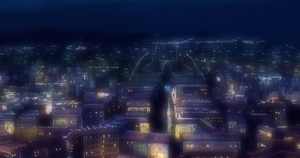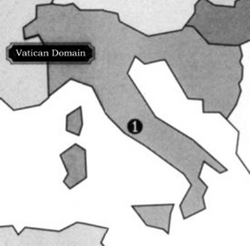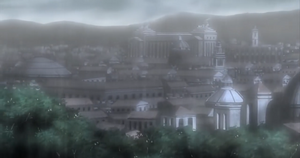- "Wow…"
"Yes… Beautiful, isn't it? Simply breathtaking—and it should be. After all, this [Rome] is the center of the modern world—the height of human existence." - ―Esther Blanchett and Abel Nightroad[src]
Rome (Latin: Roma), also known as the Eternal City (Roma Aeterna) and Capital of the World (Caput Mundi), is the capital city of the Vatican Papal State and the home of the Roman Catholic Church. As one of the birthplaces of Western culture and the heart of Terran civilization, the city is widely regarded as the center of the modern world.
The papacy, the center of the Vatican government, is located in Rome. Since the 1st century AD, the city has been the residence of the Bishop of Rome—the leader of the Catholic Church—commonly known as the Pope. The various government ministries and departments are headquartered in the city, including the Ministry of Holy Affairs, the Papal State Affairs Special Operations Section, the Ministry of Doctrine, and the Department of Inquisition.
Rome is home to many national monuments that survived Armageddon and the Dark Ages, including the Colosseum, the Pantheon, and the Monument to Vittorio Emanuele II. Other notable sites that still remain intact are the Piazza Navona, the Spanish Steps, the Trevi Fountain, the Lateran Palace, the Archbasilica of St. John Lateran, and the Castle of San Angelo. With the exception of St. Peter's Square, the area of Vatican City has undergone an extensive redesign.
History
Pre-Armageddon
Founded in the central-western portion of the Italian Peninsula along the shores of the River Tiber on 21 April 753 BC, the history of Rome spans more than three and a half thousand years. In Ancient times, it was the successive capital of the Roman Kingdom, the Roman Republic, and the Roman Empire. With the fall of the Empire in the West, political control over Rome gradually defaulted to the Pope, the leader of the Roman Catholic Church, until it finally became the capital of the Papal States in the 8th century AD. Control of the city was wrested away from the papacy by the Kingdom of Italy in 1870 AD, resulting in a dispute between state and church until it was resolved in 1929 AD with the establishment of Vatican City as the sovereign territory of the Holy See. In 1946 AD, the Italian Kingdom was reorganized into the Italian Republic, the last government headquartered in Rome before the destruction of the old world.
Armageddon and the Dark Ages
When the Earth's nations collapsed in the wake of Armageddon, the apocalyptic war of 2124 AD that left the world in a state of ruin, the Catholic Church ultimately survived and reclaimed political power over the city of Rome, now the capital of the Vatican Papal State. During the Dark Ages, Rome was the center of Terran resistance against the Methuselah—former Mars colonists who returned to Earth and developed vampiric abilities due to their exposure to the Kudlak Bacillus. By 2220 AD, the Human-Methuselah war ended with a decisive Terran victory. As a result of the Vatican's leading role in the conflict, Rome became the most significant and politically influential city in Terran society. By the 31st century AD, it was regarded as the greatest city in the world and the closest thing to Heaven on Earth.[10]
Holy Era
- "Rome—the greatest city in the world—ignorant of grief, quietly dozed in transient peace."
- ―Caterina Sforza[src]

Night view of Rome, 3060 AD.
The Terran victory preserved the human race against annihilation, but did not end the struggle between humans and Methuselah. While power and influence in the west were consolidated under the Vatican, the vampires secured the east as their domain—now known as the New Human Empire. The world situation developed into a cold war state between Rome and Byzantium—the political capitals of the Vatican and the Empire, respectively. The Vatican-Imperial stalemate has remained in effect for over six centuries with neither side gaining a distinct advantage over the other. Although some people from both races desire another war, both governments have gone to great lengths to maintain the uneasy peace between their respective nations.[2][11]
Alfred, Duke of Meinz and a member of the terrorist group known as the Fleur du Mal, hijacked the Albion airship Tristan in early 3060 AD, intending to crash it into the Pope's Vatican headquarters in Rome. Cardinals Caterina Sforza and Francesco di Medici, both high-ranking officials in the Church and half-siblings to Pope Alessandro XVIII, were divided in their respective views on how the Vatican should respond to the terrorists' threat. Medici advocated for a swift military retaliation by using a Vatican missile to destroy the Tristan before it could reach Rome—a move which Sforza opposed on the grounds that it would damage Vatican-Albion relations.[2]
Although Medici managed to convince the Pope to support his plan, the terrorist attack was ultimately prevented by Father Abel Nightroad, a Vatican priest and AX agent, who was returning to Rome at the time by way of the Tristan. Before Nightroad could fully interrogate the terrorist, Meinz unwillingly committed suicide as a result of hypnotic programming.[12] The Tristan completed its journey to Rome without further incident under the control of Jessica Lang, a flight stewardess and pilot-in-training.[2]

(1) Rome; Vatican Papal State (Vatican Domain).
Several months after the failed terrorist attack by the Fleur du Mal, Rome was nearly destroyed by another attack in late 3060 AD. Archbishop Alfonso d'Este, the former leader of the College of Cardinals and uncle of Pope Alessandro XVIII, conspired to destroy the city, along with the Vatican government, in order to establish a "new" Vatican—led by himself as pope. The attack was scheduled to take place on the day of the Combined Mass ceremony, an event which d'Este used as an excuse for returning to Rome under the false pretense of reconciling with his family; of which he became estranged from ever since Alessandro defeated him in the last papal election.[6]
The instrument of d'Este's attack on Rome was the Silent Noise device, a weapon of mass destruction with the capacity to destroy an entire city. The weapon consisted of two separate components, each disguised as a gift—an obelisk and a bell—to honor the greater glory of the Catholic Church and the majesty of Rome. Due to the intervention of the AX, Rome was saved from destruction and d'Este was arrested for treason.[7]
Although the two terrorist attacks of 3060 AD were carried out unsuccessfully by the Fleur du Mal and the so-called "New Vatican," respectively, both plots were secretly manipulated by a third party: the Rosencreutz Orden[2][7]—an international terrorist organization determined to prevent a lasting peace between Terrans and Methuselah by igniting a full-scale war between the Vatican and the Empire.[13]
Cityscape
- "Rome—the closest city to Heaven on Earth—was furnished with architecture of perfect beauty and complete harmony."
- ―Caterina Sforza[src]

A cityscape view of Rome.
The architecture of Rome has been greatly developed over the centuries, from the Classical style of Ancient Rome to the modern Fascist design of the mid-20th century AD. In spite of both Armageddon and the subsequent Dark Ages, the city of Rome and its numerous monuments have been well preserved throughout the second millennium. Many areas and national monuments throughout the city remain in their pre-Armageddon conditions with few alterations, including the Colosseum, the Pantheon, the Trevi Fountain, the Spanish Steps, the Piazza Navona, the Monument to Vittorio Emanuele II,[3] the Lateran Palace,[8] the Archbasilica of St. John Lateran,[3] and the Castle of San Angelo.[12]
Unlike most of the rest of Rome, the modern day Vatican has undergone a significant redesign. San Pietro Cathedral, the seat of the Pope of the Catholic Church, was constructed on the site of St. Peter's Basilica. Despite the radical difference in their exterior appearances, and with the exception of the papal throne room, the cathedral's interior design had direct inspiration from the Michelangelo-Maderno plan—an example of which was the old basilica's dome. San Pietro Plaza, a large plaza located directly in front of the cathedral, is virtually identical to St. Peter's Square in appearance, which includes the fountains designed by Bernini and an obelisk donated from the Kingdom of Germanicus. The obelisk was placed in the center of the plaza in 3060 AD, roughly a century after an earthquake in Rome destroyed the original obelisk.[4] The area that roughly covered the territory of Vatican City is now surrounded by a rectangular moat. The Vatican complex is connected to the city of Rome in all four directions via several bridges, including a main bridge that spans the Tiber.[3]
Education
The University of Rome is an educational institution located in Rome. Professor William Walter Wordsworth, a Vatican priest and AX agent, is a member of the University's faculty staff.[3]
Read More
Appearances
Novels
- Trinity Blood: Rage Against the Moons - Volume 1: From the Empire (First appearance)
- Trinity Blood: Rage Against the Moons - Volume 2: Silent Noise
- Trinity Blood: Rage Against the Moons - Volume 3: Know Faith
- Trinity Blood: Rage Against the Moons - Volume 4: Judgment Day
Anime
- Trinity Blood Episode 1: Flight Night
- Trinity Blood Episode 5: Yesterday, Today and Tomorrow
- Trinity Blood Episode 6: Sword Dancer
- Trinity Blood Episode 7: Never Land
- Trinity Blood Episode 8: Silent Noise
- Trinity Blood Episode 9: Overcount I. The Belfry of Downfall
- Trinity Blood Episode 10: Overcount II. Lucifer's Choice
- Trinity Blood Episode 11: From the Empire
- Trinity Blood Episode 20: The Throne of Roses I. Kingdom of the North
- Trinity Blood Episode 23: The Crown of Thorns I. City in the Mist
- Trinity Blood Episode 24: The Crown of Thorns II. The Lord of Oath
Notes and references
- ↑ Wikipedia: Founding of Rome
- ↑ 2.0 2.1 2.2 2.3 2.4 2.5 2.6 2.7 2.8 2.9 Trinity Blood Episode 1: Flight Night
- ↑ 3.0 3.1 3.2 3.3 3.4 3.5 3.6 3.7 Trinity Blood Episode 5: Yesterday, Today and Tomorrow
- ↑ 4.0 4.1 Trinity Blood: Rage Against the Moons - Volume 2: Silent Noise, Chapter 3: Overcount
- ↑ Trinity Blood: Rage Against the Moons - Volume 1: From the Empire, Chapter 1: Flight Night
- ↑ 6.0 6.1 6.2 Trinity Blood Episode 9: Overcount I. The Belfry of Downfall
- ↑ 7.0 7.1 7.2 Trinity Blood Episode 10: Overcount II. Lucifer's Choice
- ↑ 8.0 8.1 Trinity Blood: Rage Against the Moons - Volume 4: Judgment Day, Chapter 1: Lady Guilty
- ↑ Trinity Blood: Rage Against the Moons - Volume 4: Judgment Day, Chapter 3: Judgment Day
- ↑ Trinity Blood: Rage Against the Moons - Volume 2: Silent Noise, Chapter 2: Silent Noise
- ↑ Trinity Blood Episode 20: The Throne of Roses I. Kingdom of the North
- ↑ 12.0 12.1 Trinity Blood: Rage Against the Moons - Volume 1: From the Empire, Chapter 1: Flight Night
- ↑ Trinity Blood Episode 18: The Night Lords IV. The Palace of Jade
